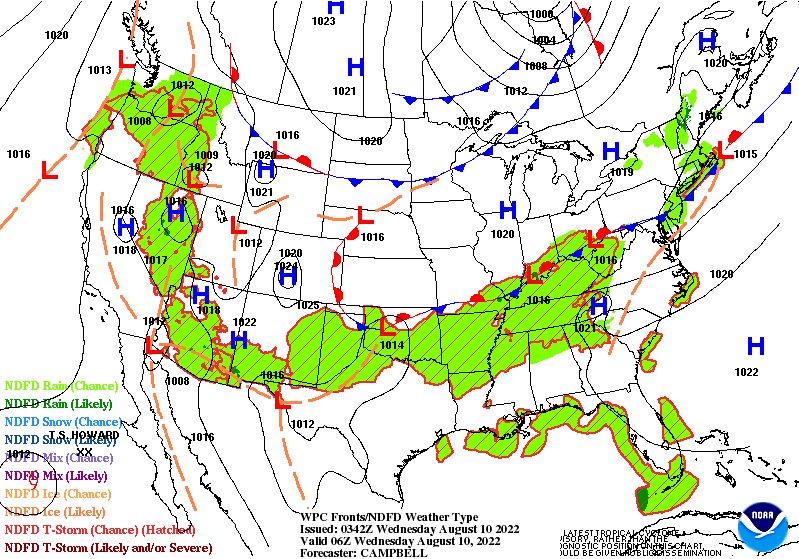Here is what we are paying attention to this evening and the next 48 hours from this evening’s NWS Forecast.
...Hot weather to continue from the Northwest into the Plains, some relief by Wednesday for the Northeast... ...Heavy Rain and Flash Flooding threat from the Ohio Valley into the Central Appalachians... ...Monsoonal Showers to continue from the Southwest, portions of California and into the Great Basin...
Continuation of the NWS Short Range Forecast (It is updated twice a day and these updates can be found here.
A key weather story over the Lower 48 today remains the prolific heat over the Interior Northwest and I-95 corridor in the Northeast, with modest relief from the record high temperatures anticipated this week. Over the Northwest, the heat streak is forecast to moderate some over the next several days, although notable above average temperatures will linger over the Interior Northwest before spilling into the Plains by midweek. This will translate to daily high temperatures to the mid-upper 90's over parts of the Interior Northwest and east across the Plains. Heat advisories and Excessive Heat Warnings are in effect across eastern Washington, Oregon and northern Idaho through the afternoon. Moreover, the warm weather and gusty winds will support an Elevated fire weather risk tomorrow across portions of the Interior Northwest, per the Storm Prediction Center. Meanwhile, cooler temperatures will begin to filter into the Great Lakes and Northeast today and continue through Wednesday as a slow moving cold front meanders south across the Interior Northeast into the Upper Mississippi Valley. Much of the East will have another day of the heat before temperatures start to moderate to around average, before a secondary cold front in Canada brings a reinforcing shot of cool air into the region by the end of the work week. Temperatures aside, showers and thunderstorms developing ahead of and along the slow moving lead cold front will bring a threat of heavy rainfall and flash flooding from the Mississippi Valley to the Central Appalachians; these locations have been very wet the last few weeks, so it would not take much rain to cause flash flooding. As such, WPC maintains a Slight Risk (level 2/4) of Excessive Rainfall across the Mississippi Valley into the Central Appalachians through Thursday. The Western half of the CONUS remains wet, too. A stagnant area of upper high pressure will build across the Rockies, in turn pushing deep layered moisture northward. This above average moisture will help trigger widespread scattered monsoonal showers and thunderstorms across these areas over the next few days. Isolated flash flooding is possible across these areas, especially over burn scars, slot canyons, dry river beds or urban areas. The Southeast quarter of the Lower 48 will also hold in a stagnant, wet pattern. The frontal boundary pressing into the Ohio Valley and Northeast will not make much headway south through this week, keeping the Southeast in the warm sector through Thursday. As such, expect widespread showers and thunderstorms in the region, where portions of the Lower Mississippi Valley and Central Gulf Coast have the best chances for heavy rains. The clouds and rain across this area will also keep high temperatures over the next few days slightly below average.
Maps that relate the forecast to geography can be found by clicking Here for Day 1 and Here for Day 2.
Here is a 60-hour animated forecast map that shows how the short-term forecast is expected to play out.
If it needs to be updated click here.
HAZARDS OUTLOOKS
Click h ere for the latest complete Day 3 -7 Hazards forecast which updates only on weekdays. Once a week probably Monday or Tuesday I will update the images. I provided the link for readers to get daily updates on weekdays. Use your own judgment to decide if you need to update these images.
Worldwide Tropical Forecast
(This graphic updates on Tuesdays) If it has not been updated, you can get the update by clicking he re
Detailed Maps and Reports for the Western Atlantic and the Pacific Oceans
Below are three maps that summarize the situation for the Atlantic, Eastern and Central Pacific. Additional information can be accessed by clicking HERE
First the Atlantic
Click to view the forecast map and have access to additional information https://www.nhc.noaa.gov/gtwo.php?basin=atlc&fdays=5
Then Eastern Pacific
Click to view the forecast map and have access to additional information https://www.nhc.noaa.gov/gtwo.php?basin=epac&fdays=5
Then Central Pacific
Click to view the forecast map and have access to additional information https://www.nhc.noaa.gov/gtwo.php?basin=cpac&fdays=5
And the Western Pacific
Click to view the forecast map and have access to additional information https://www.metoc.navy.mil/jtwc/jtwc.html
Some Intermediate-Term Outlooks
Links to “Outlook” maps and discussions for three time periods. Days 6 – 10, Days 8 – 14, and Weeks 3 and 4. An outlook differs from a forecast based on how NOAA uses these terms in that an “outlook” presents information from deviation from normal and the likelihood of these deviations.
You have to click on the links because they do not update automatically and I do not want to have stale images in the article. But it is not difficult to click on a link and you get a large image plus a discussion. On Fridays in a separate article, we will show the images and provide a link in this article that article. But remember what you will see is the images as of Friday. But here you can get the current images simply by clicking on them. Then hit the return arrow at the upper left of your screen to return to the article. You will not find this information easily anywhere else.
Right now you can find these maps here (We show them every Friday there but you can click above and find them).
World Forecast for Day 6 (Currently Set for Day 6 but the reader can change that)
World Weather Forecast produced by the Australian Bureau of Meteorology. Unfortunately, I do not know how to extract the control panel and embed it into my report so that you could use the tool within my report. But if you visit it Click Here and you will be able to use the tool to view temperature or many other things for THE WORLD. It can forecast out for a week. Pretty cool. Return to this report by using the “Back Arrow” usually found top left corner of your screen to the left of the URL Box. It may require hitting it a few times depending on how deep you are into the BOM tool. Below are the current worldwide precipitation and air pressure forecasts for six days out. They will not auto-update and right now are current for Day 6. If you want the forecast for a different day Click Here I will try to update this map each day but you have the link so you can access the dashboard and get a wide variety of forecasts.
I mostly rely on the reader to interpret world maps. For this map, areas of expected precipitation for the date and time shown are clearly shown.
The number of High-Pressure systems shown is called the Wave Number. Maybe I will discuss WN someday. But it shows how many Rossby Waves there are around the World. Sometimes they are hard to count. Counting Low-Pressure systems should provide the same WN. Rossby Waves are the way the temperature distribution of the Planet remains in balance. It is basically the science of fluid dynamics. It can be very helpful in predicting the movement of weather patterns.
Month to Date Information
Month to date Temperature can be found at https://hprcc.unl.edu/products/maps/acis/MonthTDeptUS.png
Month to date Precipitation can be found at https://hprcc.unl.edu/products/maps/acis/MonthPNormUS.png







